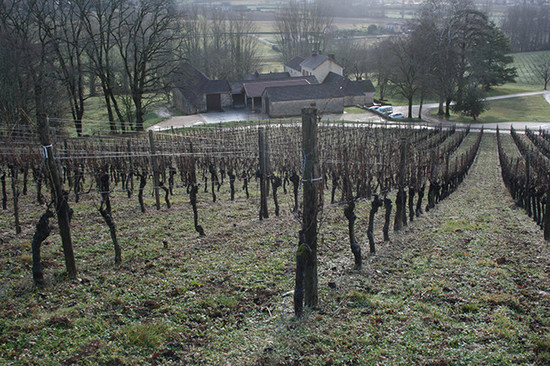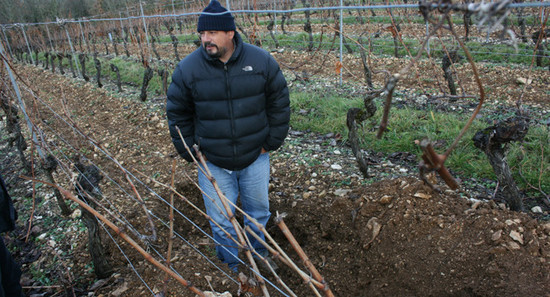Just over a year ago, I was first in touch (by email) with Antonio Morescalchi of Altos Las Hormigos in Mendoza regarding Cahors. What he told me was fascinating.

In the summer of 2013, he and Chilean soil consultant Pedro Parra had organized a trip to Burgundy and the Rhône for fellow South American wine producers. They had a free weekend, so after a Saturday spent with Jean Gardiès in Roussillon, they thought they’d go and take a look at Cahors, the home of Malbec. They weren’t expecting to get any grower appointments (France being shut on Sundays), but thought it might be fun to poke about anyway.
They were reckoning without Cahors’ dynamic marketing director, Jérémy Arnaud. Sunday or not, Jérémy made sure that local producers were waiting for the South Americans, together with a mass of opened wines arranged by style and price, and a regional seminar to boot.
How did Morescalchi and Parra repay this kindness? “At the end of the afternoon,” Morescalchi told me, “while chatting with a producer in his charming small cave, possibly rendered less diplomatic by a few glasses of Malbec, I spilled my inner thoughts. ‘Guys, you are not making terroir wines here.’” “Limestone,” added Parra, “is the best party in the wine world, and Cahors is thrashing its ticket.” What they had tasted, they felt, was `too much’.
“Most of the wines,” in Morescalchi’s words, “were so big, fruity and powerful that the sought-after texture we love so much was completely disguised, and the freshness lost. So the limestone character was showing very little, if at all.” They decided to do something about it.
The pair returned with Altos Las Hormigos’ consulting winemaker Attilio Pagli, and organized a vast tasting to try to find the terroir potential they were looking for. (I have done at least three monster tastings of Cahors with much the same aims, and believe me, this is a challenging exercise.) They picked out 12 domains where they felt they could taste ‘the limestone character’, visited all of them, and looked at their vineyards. They then talked seriously to six domains, and eventually decided to work with three.
The Alto Los Hormigos winemaker Leonardo Erazo Lynch comes across to Cahors for a month-and-a-half every harvest, while the other three visit when they can. They have insisted on hand-harvesting (rare in modern Cahors), with full destemming, very gentle pigeage, and ageing in concrete tanks alone. The brand name they’ve chosen is ‘Causse de …’ plus a different name for each domain. In two of the three cases, there is a less expensive ‘Terrasses’ version as well as a prestige ‘Plateau’ version.
Let me stop the story at this point to say that I was initially puzzled when I read Antonio Morescalchi’s remarks. I love contemporary Cahors, and don’t find it lacking in terroir character; moreover the Lot’s upper river terraces (which is where the most powerful wines come from) strike me as having as great an expressive potential as the limestone uplands. (We don’t know about the slopes between the two as they are still largely unreplanted, as described in last week’s blog.) Although oak is certainly overdone in Cahors on occasion, as it is everywhere else, I am not opposed to ‘big’ wines in principle, and have enjoyed those of Cahors very much in the past.
Now I’ve tasted the joint-venture wines which the Hormigos team have created, though, I can see what they were looking for (see below). I’m astonished, in fact, with the way in which they have been able to target, to find and to nourish a particular aesthetic incarnation of Cahors (which Parra himself is convinced derives from the limestone). I still believe that Cahors is more than the particular style they have brought into prominence, but I suspect that these wines will be influential, particularly once the 2015 vintage has been bottled.
“We are not big investors, but we are big mouths,” says Morescalchi. Sometimes that’s just what you need.

The domains
The three chosen by Parra, Morescalchi, Erazo and Pagli are all on the uplands, and set well back from the river.
The first, Causse du Théron, comes from Métairie Grande du Théron in Prayssac, run by the indefatigable former grower’s leader Jean-Marie Sigaud and his sons Sebastien and Pierre, where the South Americans had an ‘at last’ moment after tasting their first wine from concrete tanks (“we’ve found the Musigny of Cahors”, Parra recalls). The Plateau wine here comes from a large, south-facing slope cleared and planted by Jean-Marie. Parra describes its soil as a limestone alterite (the soil is visually similar, for what that may be worth, to that of many mid-slope vineyards on the Côte d’Or).
The second, Causse du Vidot, comes from Château les Croisille in Luzech, run by young Germain Croisille and his father Bernard. This is the highest and coolest of the three sites, with the heaviest clays; while the third, Causse des Ons, is from Domaine du Prince in St Vincent Rive d’Olt, run by brothers Didier and Bruno Jouve: the airiest site with the best-drained soils of the three (limestone with sand and silt).
All three families have welcomed the partnership. “They forced us to do what we never dared to do ourselves,” says Sébastien Sigaud. “To go back 30 years, and use the methods of our grandfathers. We weren’t sure we could make it pay, but they’ve given us confidence.” Bruno Jouve puts it differently: “They gave us a kick up the backside – but it’s been very good for us.” “After 15 minutes with Leo,” remembers Germain Croisille, “I’d learned things that it would have taken me five years to teach myself. I’ve completely changed our own range since. My ideal now is to make a Burgundy-like Malbec.”
Tasting
None of the wines have been launched yet, and few have been bottled. Given this, here is a brief tasting overview of the Causse du Théon and Causse du Vidot wines (the Causse des Ons blends weren’t finished when we were together in Cahors). The limestone-derived ‘minerality’ which is Parra’s focus is apparent, I would suggest with some caution, via a subtle textural granularity and a sense of density, strike, length and seriousness of flavour behind the vivacious fruits and their bright acidities. For a more lavish description, see Antonio Morescalchi’s remarks in the box below.
Causse du Théron
Causse du Théron 2014 Terrasse (bottled)
A touch of reduction, with stony, bay leaf and woodland aromas rather than fruits. On the palate, very pure and driving, with redcurrant pungency and root spices; almost austere to finish. [89]
Causse du Théron 2014 Plateau (tank sample)
Also slight aromatic reduction here with a concentrated, lean, athletic palate with more of a glow to the fruits and some firm shaping tannins. [89-91]
Causse du Théron 2015 Terrasse (tank sample)
A pristine aromatic profile: pretty violets and red cherries. Intense, explosive, brisk and bright palate characterized by almost-sour red fruits and delicate tannin, sweetening and filling a little towards the end. [90-93]
Causse du Théron 2015 Plateau (tank sample)
Another aromatically beguiling wine, with vivacious red and black fruits. A perfumed cascade on the palate of red cherry with wild elder and sloe; sumptuous, grainy textures. Pure yet dramatic. [90-95]
Causse du Vidot
Causse du Vidot 2014 Terrasses (bottled)
Some reduction; dark, spear-like elder, sloe and damson fruit with an almost raw but agreeably saline edge. On the edge of ripeness for me. [86]
Causse du Vidot 2014 Plateau (tank sample)
A much sweeter nose, blind, you might almost guess this wine was oaked. On the palate it is very chunky, with concentrated, structured and brightly acidic fruit – almost a kind of Madiran style: the clay at work? [89-91]
Causse du Vidot 2015 Terrasses (tank sample)
A magnificent scent at this stage: billowing elderberry fruits, both sweet yet fresh and lifted, too. On the palate, this is dense, bright-fruited, crisply energetic, again with a saline-earthy edge, structured by its vivacious, poised acidity rather than tannins. [90-92]
Causse du Vidot 2015 Plateau (tank sample)
Sweet, enchanting cherry-blossom scents, though with a little less focus and push than for the Terrasses at this stage. Impressive purity and finesse on the palate: a snowstorm of petals and leaves, with crisp red-fruit edges, and textured and fine-grained tannins. Perfumed to the last. [91-93]
Morescalchi on ‘3-D tannins’ and the taste of a limestone terroir
“All wines have flavour. Some just have flavour. The most interesting wines, though, have a tension which becomes an aftertaste when you spit or swallow. Tannin without minerality leaves a simple sensation, which can be dry or harsh but which is more or less uniform, whereas mineral tannins touch the tastebuds like a million minuscule flexible nail tips, creating a feeling of slight tension in the mouth. After you’ve swallowed, there is a pronounced aftertaste, together with the impression of the ghost of some fizzy coarse ground candy melting in the mouth. I know it’s a strange description, but I think it’s caused by saliva proteins reacting with the tannins, with different acids as catalysts. Some soil types, and notably limestone, which are derived from broken-down mother rock, which have balanced fertility, a well-adapted variety and well-judged ripening give you ‘3-D’ tannins of this sort. They are much more interesting in the mouth than others.”
Translated by Sylvia Wu / 吴嘉溦
All rights reserved by Future plc. No part of this publication may be reproduced, distributed or transmitted in any form or by any means without the prior written permission of Decanter.
Only Official Media Partners (see About us) of DecanterChina.com may republish part of the content from the site without prior permission under strict Terms & Conditions. Contact china@decanter.com to learn about how to become an Official Media Partner of DecanterChina.com.


Comments
Submit